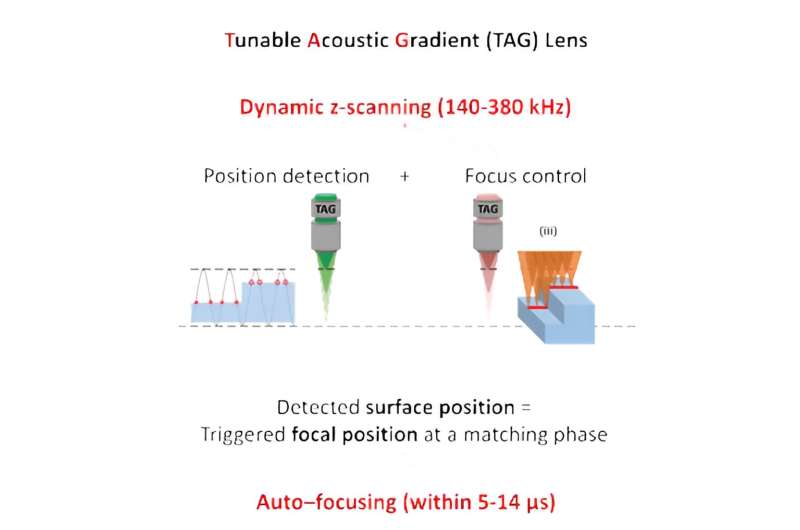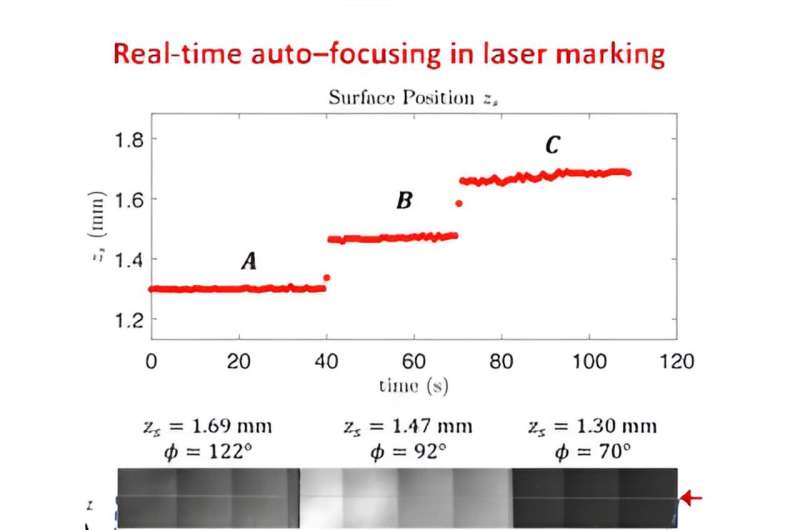This article has been reviewed according to Science X's editorial process and policies. Editors have highlighted the following attributes while ensuring the content's credibility:
fact-checked
peer-reviewed publication
trusted source
proofread
Dynamic z-scanning for ultrafast auto-focusing in laser processing

In laser-based manufacturing, accommodating non-flat, or changing surfaces has traditionally been labor-intensive, involving complex focus mapping procedures and or ex-situ characterization. This often results in repositioning errors and extended processing times.
To address these issues, ultra-high-speed auto-focusing in laser processing has been developed. Whereas most auto-focusing techniques still require the mechanical motion of a motorized stage. This mechanical movement in the beam propagation axis can be significantly slower than the lateral speed, slowing down the process of surface detection and re-alignment. Furthermore, it requires feedback, control, and sensing methods in order to determine the optical focal position.
In a new paper published in Light: Science & Applications, a team of researchers, led by Professor Craig B. Arnold from the Department of Mechanical and Aerospace Engineering at Princeton University, U.S., developed a fast method to simultaneously track the specific location of a surface and adjust the focus of an optical system. They employed axial varifocal optics, specifically a TAG lens, which operates at 0.1-1 MHz, bypassing delays from the mechanical motion in the beam propagation direction.
The team innovatively used dynamic z-scanning for both detection and movement simultaneously without any mechanical axial movement. The time between surface detection, focus retrieval, and firing of the fabrication laser pulse is theoretically within two periods of z-scanning, or several microseconds, significantly faster than any mechanically based re-focusing system combined with secondary surface position sensing elements.
The team explained the operational principle of their auto-focusing method, "We integrated a single varifocal lens into a dual laser beam setup, consisting of a probing beam and a fabrication beam. The probing beam scans continuously along the z-axis, and the temporal response of its reflection is related to the surface location."
"Simultaneously, we guide the fabrication beam to the desired position by triggering the fabrication laser at the appropriate time. This approach reduces defocused laser pulses and increases the processing speed when processing non-flat or changing samples."

The researchers also highlighted the potential of this technique for auto-focusing with a lab-made real-time detection and focusing system, designed to instantaneously follow the surface topography without any mechanical movement in the z-direction.
"This novel solution for axial focus alignment opens new possibilities for material processing of non-flat and variable surfaces at high speeds. We believe the shift from mechanical motion of optical elements to dynamic beam shaping of light will keep inspiring more exciting applications in optical metrology and 3D laser manufacturing."
More information: Xiaohan Du et al, Single-lens dynamic z-scanning for simultaneous in situ position detection and laser processing focus control, Light: Science & Applications (2023). DOI: 10.1038/s41377-023-01303-2
Journal information: Light: Science & Applications
Provided by Chinese Academy of Sciences





















